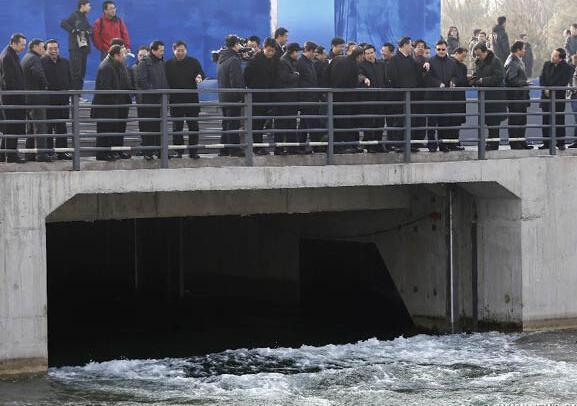
The water from a south China river flowed into Beijing on Saturday after a journey of over 1,200 kilometers along the South-to-North Water Diversion Project.
It took 15 days for the water to arrive in Beijing from its source -- the Hanjiang River, a tributary of the Yangtze River, China’s largest waterway.
Saturday’s delivery marks the completion of the middle route’s first stage, construction of which began exactly 12 years ago.
The project will have significant economic, social and environmental impacts, said E Jingping, chief of the State Council's South-to-North Water Diversion Project Commission Office. Next year, about 800 million cubic meters of water will be sent to Beijing from the south.
Beijing, on average, consumes 3.6 billion cubic meters of water annually and the project will eventually deliver 1 billion cubic meters of water to Beijing. The water resource per capita in Beijing is one eightieth of the world average. The project will alleviate the pressure Beijing faces to meet demand, said Sun Guosheng, director of the project’s Beijing office, but the project would not completely solve Beijing’s water issues. Additional measures must be taken.
The middle route’s first stage starts at the Danjiangkou Reservoir in the central province of Hubei. The middle route will supply 9.5 billion cubic meters of water annually to northern regions, including the cities of Beijing and Tianjin, and provinces of Henan and Hebei.
本时文内容由奇速英语国际教育研究院原创编写,禁止复制和任何商业用途,版权所有,侵权必究!
1.Where did the water come from that flowed into Beijing on Saturday?
A the Yellow River.
B the Hanjiang River.
C the Huai River.
D the Lancang River
解析:选B。B 细节理解题。根据第2段It took 15 days for the water to arrive in Beijing from its source -- the Hanjiang River,…可知,故选B。
2.What impact is NOT mentioned after the project is completed?
A Economic.
B Environmental.
C Social.
D Politic.
解析:选D。D 细节理解题。根据第4段第1句The project will have significant economic, social and environmental impacts,…可知,故选D。
3.How much water will flow into Beijing in 2015?
A 800 million cubic meters.
B 3.6 billion cubic meters.
C 9.5 billion cubic meters.
D 4.5 billion cubic meters.
解析:选A。A 细节理解题。根据第4段最后一句Next year, about 800 million cubic meters of water will be sent to Beijing from the south.可知,故选A。
4.Which statement is RIGHT according to the passage?
A 800 million cubic meters of water is enough for Beijing.
B 1billion cubic meters of water is enough for Beijing.
C Beijing still need 2.6 billion cubic meters of water per year after the project is completed.
D There is no need to take any measures to solve Beijing’s water issues after the project is completed.
解析:选C。C 内容理解题。根据第5段北京每年要消耗3.6 billion立方米的水,而南水北调工程建成后每年能为北京提供1 billion立方米的水,所以北京每年尚需2.6 billion立方米的水,故选C。
5.Northern regions in China have________than southern regions in China.
A more water
B less water
C fewer water
D little water
解析:选B。B 判断推理题。既是南水北调工程,说明北方的水比南方少,故选B。